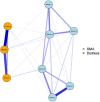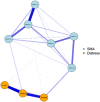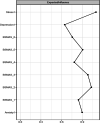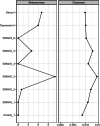Conceptualising social media addiction: a longitudinal network analysis of social media addiction symptoms and their relationships with psychological distress in a community sample of adults
- PMID: 37442974
- PMCID: PMC10339588
- DOI: 10.1186/s12888-023-04985-5
Conceptualising social media addiction: a longitudinal network analysis of social media addiction symptoms and their relationships with psychological distress in a community sample of adults
Abstract
Background: Problematic social media use has been identified as negatively impacting psychological and everyday functioning and has been identified as a possible behavioural addiction (social media addiction; SMA). Whether SMA can be classified as a distinct behavioural addiction has been debated within the literature, with some regarding SMA as a premature pathologisation of ordinary social media use behaviour and suggesting there is little evidence for its use as a category of clinical concern. This study aimed to understand the relationship between proposed symptoms of SMA and psychological distress and examine these over time in a longitudinal network analysis, in order better understand whether SMA warrants classification as a unique pathology unique from general distress.
Method: N = 462 adults (Mage = 30.8, SDage = 9.23, 69.3% males, 29% females, 1.9% other sex or gender) completed measures of social media addiction (Bergen Social Media Addiction Scale), and psychological distress (DASS-21) at two time points, twelve months apart. Data were analysed using network analysis (NA) to explore SMA symptoms and psychological distress. Specifically, NA allows to assess the 'influence' and pathways of influence of each symptom in the network both cross-sectionally at each time point, as well as over time.
Results: SMA symptoms were found to be stable cross-sectionally over time, and were associated with, yet distinct, from, depression, anxiety and stress. The most central symptoms within the network were tolerance and mood-modification in terms of expected influence and closeness respectively. Depression symptoms appeared to have less of a formative effect on SMA symptoms than anxiety and stress.
Conclusions: Our findings support the conceptualisation of SMA as a distinct construct occurring based on an underpinning network cluster of behaviours and a distinct association between SMA symptoms and distress. Further replications of these findings, however, are needed to strengthen the evidence for SMA as a unique behavioural addiction.
Keywords: Longitudinal network analysis; Psychological distress; Social media addiction.
© 2023. The Author(s).
Conflict of interest statement
Dr Vasileios Stavropoulos is an associate editor for BMC Psychiatry. The remaining authors (Deon Tullett-Prado, Jo Doley, Rapson Gomez, and Daniel Zarate) declare no competing interests as defined by BMC, or other interests that might be perceived to influence the results and/or discussion in this paper.
Figures




















Similar articles
-
The Longitudinal Effect of Psychological Distress on Internet Addiction Symptoms Among Chinese College Students: Cross-Lagged Panel Network Analysis.J Med Internet Res. 2025 May 2;27:e70680. doi: 10.2196/70680. J Med Internet Res. 2025. PMID: 40315013 Free PMC article.
-
Relationships between Severity of Internet Gaming Disorder, Severity of Problematic Social Media Use, Sleep Quality and Psychological Distress.Int J Environ Res Public Health. 2020 Mar 13;17(6):1879. doi: 10.3390/ijerph17061879. Int J Environ Res Public Health. 2020. PMID: 32183188 Free PMC article.
-
Comparing generalized and specific problematic smartphone/internet use: Longitudinal relationships between smartphone application-based addiction and social media addiction and psychological distress.J Behav Addict. 2020 Jun 26;9(2):410-419. doi: 10.1556/2006.2020.00023. Print 2020 Jun. J Behav Addict. 2020. PMID: 32592655 Free PMC article.
-
Behavioural modification interventions for medically unexplained symptoms in primary care: systematic reviews and economic evaluation.Health Technol Assess. 2020 Sep;24(46):1-490. doi: 10.3310/hta24460. Health Technol Assess. 2020. PMID: 32975190 Free PMC article.
-
The Association between Problematic Instagram Use, Psychological Distress, and Well-Being: A Systematic Review and Meta-Analysis.Cyberpsychol Behav Soc Netw. 2024 Sep;27(9):641-650. doi: 10.1089/cyber.2023.0222. Epub 2024 Jul 17. Cyberpsychol Behav Soc Netw. 2024. PMID: 39016530
Cited by
-
Wanting and liking of Facebook functions and their correlation to problematic use.Sci Rep. 2025 Jan 29;15(1):3643. doi: 10.1038/s41598-024-84514-w. Sci Rep. 2025. PMID: 39880878 Free PMC article.
-
The impact of social media addiction on self-esteem and life satisfaction among married couples.J Family Med Prim Care. 2025 Apr;14(4):1494-1501. doi: 10.4103/jfmpc.jfmpc_1808_24. Epub 2025 Apr 25. J Family Med Prim Care. 2025. PMID: 40396085 Free PMC article.
-
Problematic social media use mediates the effect of cyberbullying victimisation on psychosomatic complaints in adolescents.Sci Rep. 2024 Apr 29;14(1):9773. doi: 10.1038/s41598-024-59509-2. Sci Rep. 2024. PMID: 38684725 Free PMC article.
-
Toward the classification of social media use disorder: Clinical characterization and proposed diagnostic criteria.Addict Behav Rep. 2025 Apr 5;21:100603. doi: 10.1016/j.abrep.2025.100603. eCollection 2025 Jun. Addict Behav Rep. 2025. PMID: 40256627 Free PMC article. Review.
-
Exposure to online hate speech is positively associated with post-traumatic stress disorder symptom severity.Sci Rep. 2025 Aug 14;15(1):29869. doi: 10.1038/s41598-025-16168-1. Sci Rep. 2025. PMID: 40813430 Free PMC article.
References
-
- Griffiths, M. D., & Kuss, D. J. (2017). Adolescent social media addiction (revisited). Education and Health, 35(3). https://irep.ntu.ac.uk/id/eprint/31776/1/PubSub9230_Griffiths.pdf
-
- Anderson, E. L., Steen, E., & Stavropoulos, V. (2016). Internet use and problematic internet use: a systematic review of longitudinal research trends in adolescence and emergent adulthood. International Journal of Adolescence and Youth, 22(4). 10.1080/02673843.2016.1227716
-
- Gorwa R, Guilbeault D. Unpacking the social media bot: a typology to guide research and policy. Policy Internet. 2018;12(2):225–246. doi: 10.1002/poi3.184. - DOI
-
- Luo T, Qin L, Cheng L, Wang S, Zhu Z, Xu J, Chen H, Liu Q, Hu M, Tong J, Hao W. Determination the cut-off point for the Bergen social media addiction (BSMAS): Diagnostic contribution of the six criteria of the components model of addiction for social media disorder. J Behav Addict. 2021;10(2):281–290. doi: 10.1556/2006.2021.00025. - DOI - PMC - PubMed
Publication types
MeSH terms
LinkOut - more resources
Full Text Sources

